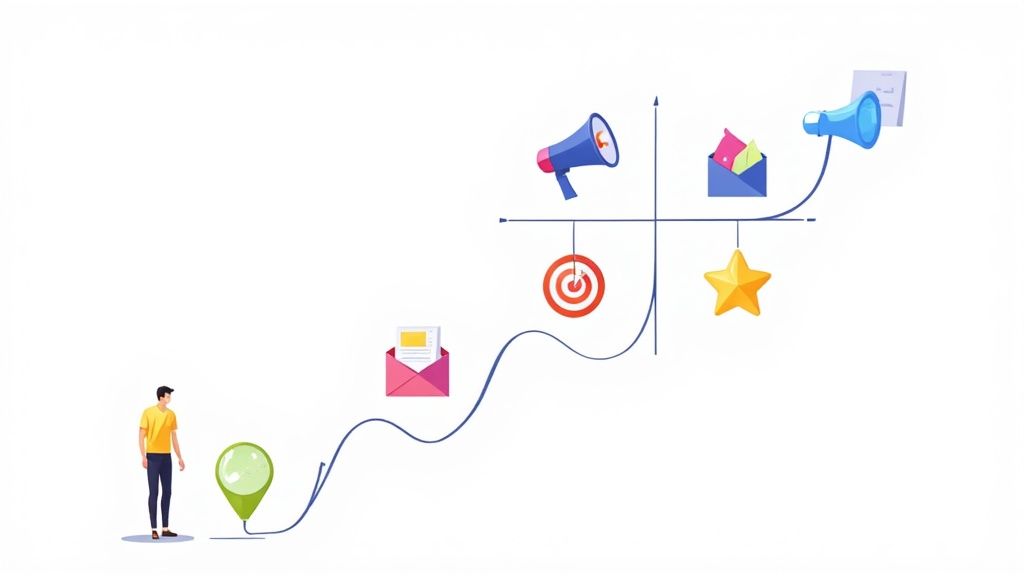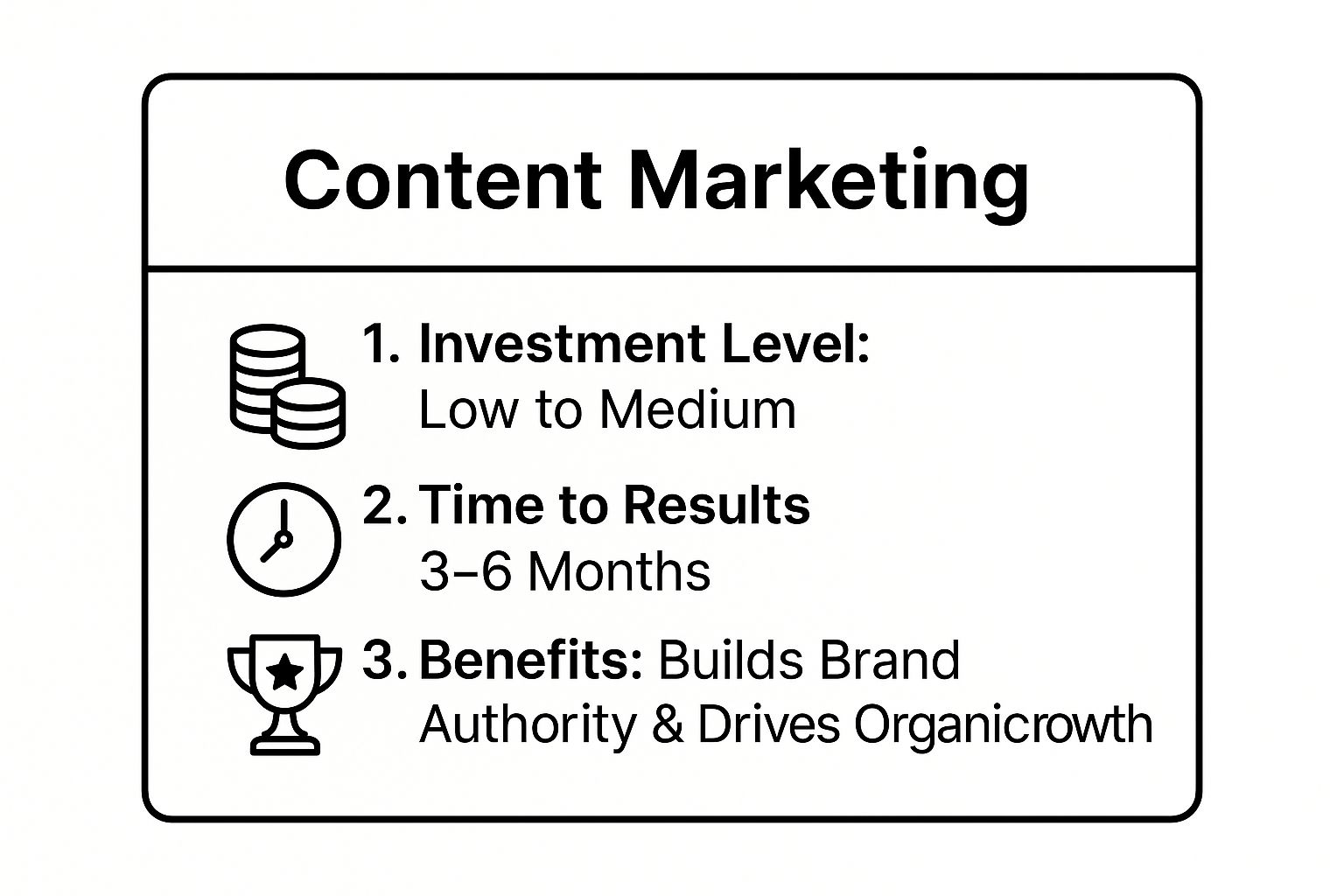Top 9 User Acquisition Strategies for Startups That Drive Growth

So you've built an amazing product, but now comes the real challenge: getting people to actually use it. If you're a startup founder or marketer, you know the pressure to grow is immense, and your budget probably isn't. The internet is flooded with generic advice, but what you need are proven, actionable user acquisition strategies for startups that you can implement right away without a massive team or a blank check.
This isn't another high-level, theoretical guide. We're getting straight to the point. We’ll break down nine powerful strategies, from content marketing and SEO to community building and product-led growth. Each section is packed with practical steps and real-world examples to help you move from idea to execution quickly. More importantly, we'll show you how to give these classic strategies a modern, Web3 twist using tools like Domino's no-code toolkit, enabling you to build sophisticated campaigns like token-gated content or NFT-based referral programs with ease.
The goal here is simple: to give you a clear roadmap for attracting your first users and scaling from there. Growing a user base is a marathon, not a sprint, and every dollar counts. A critical metric for any startup aiming for efficient growth is understanding and optimizing your Cost Per Acquisition and how to lower it. The tactics in this list are designed to do just that, helping you acquire high-value users sustainably. Let's ditch the guesswork and start building momentum.
1. Content Marketing
Content marketing is less about selling and more about teaching, entertaining, and building relationships. It’s a strategic game plan focused on creating and sharing valuable, relevant, and consistent content to attract and retain your ideal audience. Instead of interrupting potential users with ads, you pull them in by providing genuine value, making it one of the most effective user acquisition strategies for startups looking to build a sustainable growth engine.
Think of companies like HubSpot. They didn’t just build marketing software; they built a massive library of blogs, e-books, and free tools that answers virtually any marketing question. This approach established them as an authority, and now they organically attract millions of users who trust their expertise.
Why It Works for Startups
For early-stage companies, trust is a rare and valuable currency. Content marketing helps you earn it. By consistently solving your audience's problems, you build a reputation as a credible expert. This not only attracts new users through search engines and social media but also fosters a loyal community that champions your brand. It’s a long-term play that creates a moat around your business that competitors can't easily cross with a bigger ad budget.
Here’s a quick-reference summary of what to expect when you invest in content marketing.

As the data shows, content marketing requires patience, but the payoff is significant brand authority and a steady stream of organic traffic.
How to Get Started
Getting your content strategy off the ground doesn’t have to be complicated.
- Solve a Specific Problem: Don't try to be everything to everyone. Identify one major pain point your target audience faces and create the best piece of content on the internet that solves it.
- Create Pillar and Cluster Content: Develop a long, comprehensive "pillar" post on a broad topic (e.g., "A Founder's Guide to Community Building"). Then, create shorter "cluster" posts that dive into specific subtopics (e.g., "5 Ways to Onboard New Community Members"), all linking back to the pillar. This structure is fantastic for SEO.
- Repurpose Everything: Turn that one epic blog post into a Twitter thread, a LinkedIn carousel, a short video, and an infographic. Maximize your reach without reinventing the wheel.
2. Search Engine Optimization (SEO)
Search Engine Optimization (SEO) is the art and science of getting your website to the top of Google’s search results. It’s about making your startup the first thing people find when they’re actively looking for a solution you provide. Instead of paying for every click, SEO helps you earn "free" organic traffic, making it a foundational pillar among user acquisition strategies for startups aiming for long-term, scalable growth.
Think of how Zapier ranks for almost any "how to connect X and Y" search query. They didn't just build a great product; they built an SEO machine that answers user questions at a massive scale, drawing in millions of potential customers who are already problem-aware and solution-seeking.

Why It Works for Startups
For startups, especially in a niche like Web3, SEO is your direct line to users with high intent. Someone searching "how to create a token-gated community" is much closer to becoming a customer than someone who just scrolled past your ad. This intent-driven traffic converts at a higher rate and builds a powerful, sustainable acquisition channel that grows in value over time, unlike paid ads that stop the moment you stop paying.
This strategy establishes your brand as a credible authority. When you consistently show up to answer your audience's questions, you build trust and become the default choice in your space, creating a competitive advantage that’s incredibly difficult for others to replicate.
How to Get Started
You don't need to be an SEO wizard to start seeing results. Focus on the fundamentals.
- Target Long-Tail Keywords: Instead of chasing a hyper-competitive term like "NFTs," go after specific, less competitive phrases like "how to airdrop NFTs to wallet holders." These "long-tail" keywords attract a more qualified audience and are easier to rank for.
- Match Search Intent: Create content that directly answers the question a user is asking. If someone searches for a "guide," give them a comprehensive, step-by-step guide, not a sales page. Google's main job is to satisfy its users, so help it help you.
- Focus on Technical Health: Ensure your website is fast, mobile-friendly, and easy for search engines to crawl. A great user experience is a powerful ranking signal. Simple tools like Google's PageSpeed Insights can give you a clear to-do list.
3. Social Media Marketing
Social media marketing is all about meeting your users where they hang out online. It involves creating and sharing content on platforms like Twitter, TikTok, and Instagram to build brand awareness, engage with a community, and drive traffic back to your product. Instead of just pushing a product, this strategy focuses on building a brand personality that people want to connect with, making it a powerful tool in your toolkit of user acquisition strategies for startups.
Think about Duolingo’s unhinged and hilarious TikTok presence or Wendy's legendary roasts on Twitter. They don't just sell language lessons or burgers; they create entertainment and build a persona that people actively follow. This approach turns passive scrollers into engaged followers and, eventually, loyal users.

Why It Works for Startups
For startups, social media offers a direct line to your target audience without the massive budget traditional advertising requires. It’s a space where you can be human, show off your brand’s personality, and get real-time feedback. Building a community on social media creates a dedicated group of early adopters who feel connected to your mission. They become your best advocates, spreading the word far more effectively than any paid ad could. Plus, the viral potential of a single post can lead to an exponential spike in user acquisition overnight. If you're looking for more specific insights, check out our guide on crypto social media marketing.
How to Get Started
You don't need to be on every platform to succeed. Focus your efforts for maximum impact.
- Pick Your Playground: Don't spread yourself thin. Identify the one or two platforms where your ideal users are most active and go all-in there. If you’re a B2B SaaS, LinkedIn and Twitter are great. If you’re a consumer app, TikTok or Instagram might be your best bet.
- Develop a Distinct Voice: Are you witty, educational, inspirational, or a bit of a troll? Define your brand's personality and stick to it. Consistency is key to building a memorable and recognizable brand.
- Engage, Don't Just Broadcast: Social media is a two-way conversation. Respond to comments, ask questions, and jump into relevant discussions. Use social listening tools to track mentions and find opportunities to engage authentically.
4. Referral Programs
Referral programs turn your happiest users into your most effective sales team. This strategy systematizes word-of-mouth marketing by incentivizing your existing user base to bring new people into your ecosystem. Instead of you shouting from the rooftops, your users do it for you, leveraging their trust and social proof to acquire high-quality users who are often more engaged and loyal from day one.
Think about Dropbox’s legendary program. By offering extra storage space to both the referrer and the new user, they grew by 3900% in just 15 months. This two-sided incentive made sharing a no-brainer, creating a viral loop that was core to their early success and a masterclass in effective user acquisition strategies for startups.

Why It Works for Startups
Referrals are built on trust, which is a startup’s most valuable asset. A recommendation from a friend cuts through the noise of traditional advertising far more effectively. For startups, this means a lower customer acquisition cost (CAC) and often a higher lifetime value (LTV) per user, as referred customers tend to stick around longer. It’s a powerful, self-sustaining growth engine that scales as your user base grows.
This approach is particularly powerful in Web3, where communities are tight-knit and trust is paramount. A recommendation from a fellow DAO member or NFT holder carries significant weight.
How to Get Started
Building a referral program doesn't have to be a massive engineering project. The key is to make it simple and rewarding.
- Offer Two-Sided Incentives: Reward both the person referring and the new user they bring in. This creates a win-win scenario that dramatically increases participation. Think credits, premium features, or exclusive access.
- Make Sharing Effortless: The referral process should be incredibly simple. Provide a unique, easily shareable link directly within your app or platform. The fewer clicks required, the better.
- Promote It Everywhere: Don’t hide your referral program. Feature it prominently in your user onboarding, email newsletters, and within the product itself. Remind users how they can benefit from sharing.
- Automate and Track: Manually tracking referrals is a nightmare. Use tools to automate the process of generating links, tracking sign-ups, and distributing rewards. If you're building in Web3, you can launch a token-gated referral program in minutes with Domino's no-code tools. Explore Domino's referral solutions to see how you can set one up.
5. Partnership Marketing
Partnership marketing is the art of teaming up with complementary businesses to tap into their established audiences. Instead of building your user base from scratch, you leverage the trust and reach of a partner who already serves your ideal customer profile. It’s a powerful "one plus one equals three" scenario where both brands benefit from a shared value proposition, making it an incredibly efficient user acquisition strategy for startups.
Think about Spotify's early partnership with Uber. Riders could control the music directly from the Uber app, creating a seamless and enhanced experience. Uber offered a cool new feature, and Spotify got its app in front of millions of captive potential users. This wasn't a random collaboration; it was a strategic move that provided genuine value to both audiences.
Why It Works for Startups
For startups, breaking through the noise is a monumental challenge. Partnership marketing gives you a shortcut to credibility and reach. By aligning with a trusted brand, you instantly borrow some of their authority and gain a warm introduction to an audience that would have been expensive and time-consuming to reach otherwise. It’s a highly scalable channel that relies on relationships rather than just ad spend.
This approach allows you to punch above your weight, accessing distribution channels and marketing opportunities that would typically be reserved for much larger companies.
How to Get Started
Building successful partnerships is about finding the right fit and creating mutual value.
- Identify Complementary, Non-Competing Partners: Look for businesses whose products or services are used by your target audience but don't directly compete with yours. If you're building a Web3 community tool, a crypto wallet or a DAO launchpad could be a perfect partner.
- Create a "Win-Win" Offer: Your pitch shouldn't be about what you want; it should be about how you can deliver value to your partner's audience. Offer their users an exclusive discount, co-host an educational webinar, or create a valuable content collaboration.
- Start Small and Build: Don't aim for a massive co-branding deal right away. Start with a smaller initiative like a joint social media campaign or a content swap. Prove the value and build trust to lay the groundwork for a deeper, long-term relationship.
6. Product-Led Growth (PLG)
Product-Led Growth (PLG) flips the traditional sales model on its head. Instead of relying on marketing or sales teams to find and convert leads, the product itself becomes the primary driver of user acquisition, conversion, and expansion. It’s a strategy built on delivering an exceptional user experience that encourages organic growth through self-service adoption and natural word-of-mouth.
Think about how Slack took over the workplace. You didn't see a salesperson; a coworker just invited you to a channel. The product’s value was so immediate and its collaborative nature so inherent that it spread organically from team to team, and then company to company. This is the essence of PLG and a powerful user acquisition strategy for startups aiming for exponential, scalable growth.
Why It Works for Startups
For startups, PLG reduces the cost of customer acquisition significantly by minimizing reliance on expensive sales and marketing efforts. It creates a frictionless path for users to experience your product's value firsthand, which builds trust and loyalty much faster than any sales pitch ever could. This self-service model also generates a continuous feedback loop, allowing you to iterate on your product based on actual user behavior, ensuring you’re always building what people truly want.
How to Get Started
Implementing a PLG strategy requires putting your product experience at the center of everything you do.
- Deliver Value Instantly: Your onboarding process should be laser-focused on the "aha!" moment. Guide new users to experience the core value of your product within the first few minutes of signing up.
- Build Virality into the Core: Make sharing and collaboration essential features, not afterthoughts. Design workflows that naturally require users to invite their colleagues or friends, like Figma’s multiplayer design canvas or Notion's shared workspaces.
- Create a Frictionless Upgrade Path: Start users on a generous free or freemium plan. As their usage grows and they hit certain limits or need advanced features, make the upgrade process seamless and clearly communicate the value they'll receive.
7. Email Marketing
Email marketing is the art of building a direct line of communication with your audience, turning passive visitors into engaged leads and loyal users. It's not about spamming inboxes; it’s about delivering targeted value, nurturing relationships, and guiding prospects toward your product. By building a subscriber list, you create a powerful asset that isn't dependent on unpredictable algorithms, making it a cornerstone of many successful user acquisition strategies for startups.
Take Morning Brew, for example. They built a media empire by delivering a witty, digestible daily newsletter. They didn't just report the news; they created a can't-miss daily habit for millions, proving that an inbox can be a powerful channel for growth when you consistently provide value. This approach builds a direct, trusted relationship with your audience that social media simply can't replicate.
Why It Works for Startups
In the noisy world of digital marketing, email cuts through the chaos. It’s a personal, direct, and owned channel. You don’t have to pay to reach your audience once they've subscribed. This allows you to nurture leads over time, educate them about your product, and convert them when they're ready. For startups, this means a higher ROI and the ability to build a community that feels connected to your mission, all from a simple, well-crafted message.
Here’s a quick-reference summary of what to expect when you invest in email marketing.
As the data highlights, email marketing excels at nurturing leads and driving conversions through a direct and controlled communication channel.
How to Get Started
Building an effective email marketing engine is more straightforward than you might think.
- Create an Irresistible Lead Magnet: Offer something genuinely valuable in exchange for an email address. This could be a free guide, a checklist, a template, or access to an exclusive tool. Make sure it solves a real problem for your target user.
- Segment Your Audience: Don't send the same email to everyone. Group your subscribers based on their behavior, interests, or where they are in the customer journey. A new lead needs a different message than a long-time user.
- Focus on the Welcome Sequence: Your first few emails are crucial. Create an automated welcome series that introduces your brand, delivers the lead magnet, and provides immediate value. This sets the tone for the entire relationship.
8. Paid Advertising (PPC)
Paid advertising, or pay-per-click (PPC), is the fast lane of user acquisition. Instead of waiting for users to find you, you pay platforms like Google, Facebook, and LinkedIn to place your brand directly in front of a highly targeted audience. When someone clicks your ad, you pay a fee, making it a powerful and direct way to drive immediate traffic and conversions. This is one of the most scalable user acquisition strategies for startups that need to test market demand and acquire users quickly.
Think of Casper, the mattress-in-a-box company. In their early days, they used targeted Google Ads for sleep-related keywords and social media ads to reach potential customers who were actively looking for a better night's sleep. This approach allowed them to capture high-intent users at the exact moment they were ready to buy, fueling their rapid growth.
Why It Works for Startups
While organic growth builds a strong foundation, PPC delivers speed and data. For startups, it’s an invaluable tool for validating your product, testing messaging, and understanding your customer acquisition cost (CAC) from day one. You can turn the traffic on and off like a tap, giving you control and immediate feedback on what resonates with your audience. This data-driven approach helps de-risk your marketing efforts and informs your long-term organic strategy.
Here’s a quick-reference summary of what to expect when you invest in paid advertising.
As the data highlights, PPC offers immediate results and precise targeting, but requires careful budget management to remain profitable.
How to Get Started
Diving into paid ads doesn't require a massive budget, just a smart approach.
- Know Your Numbers First: Before spending a dollar, calculate your Customer Lifetime Value (LTV). This tells you how much you can afford to spend to acquire a customer and remain profitable.
- Target and Test Relentlessly: Start with a small, highly specific audience. Simultaneously run A/B tests on different ad creatives, headlines, and calls to action to see what performs best. Platforms like Facebook and Google make this easy to manage.
- Optimize Your Landing Page: Sending paid traffic to your homepage is a waste of money. Create a dedicated landing page that matches the ad's message and has one clear goal, whether it's a sign-up, a download, or a purchase.
9. Community Building
Community building is about creating a space, digital or physical, where your users feel a sense of belonging. It's not just a support forum; it’s a network of advocates, enthusiasts, and learners gathered around your brand, product, or a shared interest. Instead of just acquiring users, you’re nurturing a tribe that actively contributes to your growth, making it one of the most durable user acquisition strategies for startups.
Take Indie Hackers, for example. Courtland Allen built a platform not just to share his own journey but to create a home for other bootstrapped founders to share their stories, revenue numbers, and challenges. The community is the product. This ecosystem of mutual support organically attracts thousands of entrepreneurs looking for genuine connection and advice, creating a powerful, self-sustaining growth loop.
Why It Works for Startups
For a startup, a strong community is a competitive advantage that can't be bought. It creates an incredible feedback loop, giving you direct access to your most passionate users for product ideas and validation. This connection fosters deep loyalty, turning users into evangelists who recruit new members on your behalf. While ads can be turned off, a vibrant community becomes a permanent asset that continuously drives engagement, retention, and organic acquisition.
Pro Tip: Your community is your first and best source of user-generated content (UGC). Encourage members to share their projects, success stories, or tips, and then amplify that content across your marketing channels.
How to Get Started
Building a community from scratch requires genuine effort, not just a software platform.
- Start with Value, Not an Ask: Don't just invite people to a Slack channel and hope for the best. Host an exclusive AMA with an expert, share a valuable free resource, or create a space to solve a specific, shared problem. The initial draw must be about what they get, not what you want.
- Foster Member-to-Member Connections: Your job as a community builder is to be a facilitator. Introduce members to each other, create rituals like weekly wins or introduction threads, and celebrate user contributions. To foster a loyal and engaged user base, explore these powerful community building strategies to get started.
- Define Clear Guidelines and a Shared Purpose: A great community needs a clear mission and rules of engagement. What is the purpose of this space? What kind of behavior is encouraged, and what isn’t? Setting the tone early prevents chaos later. For more tips on this, read our guide on community engagement best practices.
User Acquisition Strategies Comparison
| Strategy | Implementation Complexity | Resource Requirements | Expected Outcomes | Ideal Use Cases | Key Advantages |
|---|---|---|---|---|---|
| Content Marketing | Medium - requires multi-format expertise | Low to Medium (time & content creation) | Long-term growth (3-6 months), brand authority | Brand building, SEO, organic growth | Builds trust, SEO benefits, cost-effective |
| SEO | High - technical and ongoing optimization | Low to Medium (technical skills) | Long-term organic traffic (6-12 months) | Discoverability, intent-driven traffic | Sustainable traffic, high conversion rates |
| Social Media Marketing | Medium - platform-specific content and engagement | Low to High (content + ads) | Short-term to medium (1-3 months), viral reach | Brand awareness, user engagement | Direct engagement, viral potential |
| Referral Programs | Medium - system setup and management | Medium (incentives + management) | Short-term (1-2 months), high-quality users | User acquisition via word-of-mouth | High retention, lower CAC, viral loops |
| Partnership Marketing | Medium - negotiation and coordination | Low to Medium | Medium-term (2-4 months), access to new audiences | Access to complementary audiences | Cost-effective, credibility, strategic value |
| Product-Led Growth | High - requires product and UX excellence | High (product development) | Medium-term (3-6 months), organic product growth | SaaS, freemium models, viral product use | Scalable growth, lower marketing costs |
| Email Marketing | Low to Medium - campaign setup and automation | Low to Medium (content + tools) | Short-term (1-3 months), direct conversions | Lead nurturing, retention, personalized communication | High ROI, direct channel, personalized messaging |
| Paid Advertising (PPC) | Medium - ongoing optimization and management | Medium to High (ad spend + management) | Immediate to short-term (up to 1 month), fast traffic | Immediate user acquisition, targeted reach | Immediate results, precise targeting |
| Community Building | Medium to High - ongoing engagement required | Medium (management + content) | Medium-term (3-6 months), strong user loyalty | Brand loyalty, customer advocacy | High engagement, organic word-of-mouth |
Putting It All Together: Your Startup's Growth Engine
Alright, we've covered a ton of ground, from the evergreen power of Content Marketing and SEO to the explosive potential of Community Building and Partnership Marketing. It’s easy to look at a list of nine powerhouse user acquisition strategies for startups and feel a bit overwhelmed. Where do you even begin?
The biggest mistake is trying to do everything at once. The most successful startups don’t master all nine strategies on day one. Instead, they build a growth engine, piece by piece, starting with the channels that make the most sense for their unique product and audience. Think of this list not as a checklist to be completed, but as a menu of options. Your job is to find the perfect combination platter for your brand.
Your First Steps to Building Momentum
The key takeaway is this: user acquisition isn't a one-time campaign; it's a continuous system of experimentation and optimization. Your initial goal isn't to find the one "magic bullet" that will bring in a million users overnight. It's to find one or two channels that deliver a repeatable, scalable stream of new users.
Here's how to get started:
- Pick Your Battles: Choose two or three strategies from this list that align best with your team's skills and your target audience's habits. If you have a visually stunning NFT project, social media marketing on platforms like Instagram and X might be a no-brainer. If you’re building a complex DeFi protocol, a deep-dive content marketing and SEO strategy could be your best bet.
- Set Clear, Measurable Goals: Don't just "do social media." Aim to "gain 500 qualified followers on X in the first month" or "drive 1,000 unique visitors from organic search within the first quarter." Tangible goals force you to measure what matters and understand what’s actually working.
- Embrace the Feedback Loop: Launch, measure, learn, and repeat. Use analytics to track your efforts relentlessly. If a particular blog post is driving a ton of sign-ups, write more content like it. If your paid ads are falling flat, pause them and reallocate that budget to the referral program that’s crushing it. This iterative process is the heartbeat of any effective growth engine.
The Web3 Supercharger: Turning Strategy into Action
For startups in the Web3 space, there’s a powerful layer you can add to almost every strategy we’ve discussed: interactive, reward-based engagement. Traditional marketing asks users to consume content; Web3 marketing invites them to participate and co-create value.
Imagine turbo-charging your efforts:
- Your Content Marketing isn't just a blog post; it's a "Read & Earn" quest where users get a small token reward for answering a quiz about your article.
- Your Referral Program isn't just a link; it's an on-chain system that automatically distributes rewards to both the referrer and the new user the moment they connect their wallet.
- Your Community Building isn't just a Discord server; it's a vibrant ecosystem where members complete on-chain and off-chain tasks to earn exclusive roles, NFTs, or governance power.
This is where the classic playbook of user acquisition strategies for startups meets the future. By weaving in verifiable actions and automated rewards, you're not just acquiring users; you're building a loyal, engaged, and invested community from the very beginning. The journey from a curious visitor to a passionate advocate becomes shorter, more engaging, and far more effective. Start small, be consistent, and never stop experimenting. Your growth engine is waiting to be built.
Ready to turn these user acquisition strategies into automated, on-chain quests for your community? With Domino, you can launch reward-based campaigns for everything from social follows to content engagement in minutes, no code required. Supercharge your growth by visiting Domino and see how easy it is to build your Web3 marketing engine today.
Level Up Your dApps
Start using Domino in minutes. Use automations created by the others or build your own.
